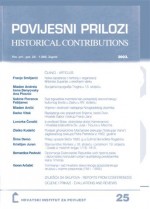
We kindly inform you that, as long as the subject affiliation of our 300.000+ articles is in progress, you might get unsufficient or no results on your third level or second level search. In this case, please broaden your search criteria.








Ансамблот Artwork, кој изведува современа музика е активен на германските музички сцени повеќе години. Ансамблот изведува современи музички дела и учествува во различни музички проекти во Германија и ширум Европа. Ансамблот го сочинуваат двајца пијанисти и двајца перкусионисти. Оваа година, тие настапија со концерт во рамките на манифестацијата „Денови на македонска музика“, изведувајќи дела од светски и македонски композитори. Разговараме со Хајди Елзесер, основач и член на ансамблот Artwork.
More...
Artwork Ensemble has been active on the German music stages for several years. The ensemble performs contemporary music and takes part in different music projects in Germany and around Europe. The members of the ensemble are two pianists and two percussionists. Artwork Ensemble performed at a concert during “Days of Macedonian Music” event, playing works by famous international and Macedonian composers. We are talking with Hajdi Elzeser, a founder and a member of Artwork Ensemble.
More...



оглед за егзилот, пишувањето, жената и „чистото“ низ дневникот и камерата на една поетеса – номад
More...
The emperor Leopold I requested Zagreb bishop Petar Petretić (1648-1667) to write a report of Greek Catholic Marča diocese. Petretić wrote the report in 1662 and described work of previous Marča bishops. He also gave an opinion about future candidates for a new Marča bishop. Petretić warned that the union of orthodox population of Military border with the catholic church was not successful and responsible for such situation were Marča bishops Maksim and Gabrijel Predojević and Sava Stanislavić. They accepted the religious union only generally and in fact they remained orthodox and protected orthodox population and considered orthodox Peć patriarchate as their religious leadership. Petretić accused Marča bishops for instigating rebellion of Military bordermen against Croatian nobility and Zagreb bishop. Military bordermen in the area of Varaždin general command lived on the land previously owned by Croatian nobility and Zagreb diocese. The conflict arose when previous owners demanded from bordermen tax for the use of their land. In his report Petretić warned that actions of Marča bishops caused the spread of orthodox religion in the Military border region. Connections between the orthodox clergy from Military border with Peć patriarchate was seen as a symbol of disloyalty toward the Austrian emperor and as a threat to the national security because orthodox clergy with its ties with Peć was also able to serve as spies of the Ottoman empire. Petretić thought that new bishop of MarËa must be a real Eastern-Rite clergyman, raised in Catholic schools. Such person would be able to break all ties with Peć patriarchate. Military border orthodox clergy would be forced to loyalty toward the Catholic Church and the emperor. This would finally result in a effective union of orthodox Military border population with the Catholic church. Vienna did not accept Petretić’s proposal because it feared that orthodox bordermen would rebel against it. It was usual for bordermen to choose Marča bishop on their own and to propose their candidate to the emperor. Contrarery to the Petretić proposals Marča deacon Gabrijel Mijakić remained the bishop. He was supported by the bodermen and he promised to accept the religious union. Although Petretić's proposals were not accepted, they were later partially put into force. Mijakić was arrested because he refused to accept the religious union. He was replaced by Pavle Zorčić, who was a real Eastern-Rite clergyman educated in the Illirian collegiate body in Bologna.
More...
Turbulent history of Syrmia was marked with numerous wars and changes of rule over that province. There are also small historical episodes connected with Syrmia, but their consequences are sometimes quite important. One of such episodes was selling of Syrmia to Livio Odescalchi. After the great war of liberation from Ottoman rule, Odescalchi used the great indeptness of emperor Leopold and in 1697 he bought famous Syrmia duchy. Croatian nobility in the Croatian Diet was also interested to take control over liberated areas and also over Syrmia. Syrmia bishop Franjo Jary also attempted to re-establish his diocese and it was only natural that he showed great interest for rich Syrmia region. Result of such conflicting interests was struggle to gain control over Syrmia but without greater changes in final results. Nevertheless such develoments later opened various possibilities for Syrmia and as a result selling of this area to Odescalchi had various positive consequences.
More...
General expansion of France during late 18th century led to vast changes in Europe that also influenced Dubrovnik Republic. France offered its revolutionary ideas reinforced through territorial expansion. Such situation led small states to a difficult situation in which they could not remain independent. England initiated various coalitions against its arch enemy France. From 1797 to 1815 Adriatic also became a war territory. Control of its eastern coast was important for France in its attempt to separate the Europe from England. Such development of events led to the destruction of Dubrovnik’s independence. Its neutrality did not suit France nor its enemies. English naval blockade of Europe completely destructed Dubrovnik’s merchant fleet and its economy. French representatives showed disrespect for Dubrovnik’s neutral policy and restraint toward French revolution. Dubrovnik could not count on strong armed forces so it always had an active diplomacy and good information gathering structure. This article presents Dubrovnik’s diplomatic activities immediately before it lost its independence.
More...
The article analyses registers of birth, marriages and deaths of Murter parish in the period from 1718 to 1815. Basic information on content and form of registers, as well as basic demographic data (annual and seasonal rate of born and baptized, married and dead, average age of men and women at the time of their wedding, age structure of those who died) are given. Information on given and family names is also presented and these data are important to discover connections of Murter population with other villages and towns. Registers also show the social differences among Murter population. Wealthier families obviously developed contats with nobility and merchants, because members of these families can be traced in registers as godfathers and witnesses. Members of more influential and wealthier Murter families often took part in the local administration (dux, sergente, capitanio, serdar) and clergy. The important feature of Murter population is continuity of traditional families. In the period of almost one century only three or four new families temporary appeared in Murter. Extinction of male members of the family was usually resolved through marriage and husband took his wife’s family name. Husbands from matrilineal marriages usually came from other Murter families and rarely from other villages. This article gives general information on demographical and statistic developments of the Murter population during 18th and early 19th century, but further research will surly give new important discoveries.
More...
Family Kamenarović from Dobrota was in the past, and especially during the 18th century, one of the leading seamen and merchant families from Boka. In the period of the successful development of Boka Kotorska seamanship, ships owned by Kamenarović family sailed to all important Adriatic and Mediterranean ports. Venetia was one of the most important and most often visited destinations. Kamenarović family did not belong to a permanent Croatian community in Venetia. Still during their visits to Venice members of Kamenarović family, as well as their fellow-citizens from Ivanović Radimiri and Tripković families, gave great support to the Croatian community in Venice and to the Croatian confraternity of St George and Tripun. Using the existing historical literature and the archival documents of the St George and Tripun confraternity (register books of income and expenses, book of reports of the annual contraternity conferences) the articles presents the involvment of the Kamenarović family in the membership and leadership of the Contraternity. It can be seen how member of this family hold the most important positions in the Confraternity and its boards and councils. Special attention is paid to the position of the head of the Confraternity. One of those who was appointed to that position was captain Pavao Jurjev. During 18th century he was a man of considerable fortune. He supported religious institutions in native Dobrota and was active as a member and patron of the Croatian community and its Confraternity in Venice. Documents of the St George and Tripun confraternity can also be used to research other influential families from Dobrota. This would give an important insight in history of Boka Kotorska Croats.
More...
The article gives an insight into the activites of the Croatian-Slavonian economic society from its creation in 1841 to the spring of 1848. and it also explains the events and developments during the period of the Croatian revival movement. This period of Croatian history was researched mostly from the perspective of political, cultural and lingustic events and developments and much less attention was given to the activities of the Croatian-Slavonian economic society. Using the press from that period as a primary source, the author presents all facts connected with the creation and activites of the mentioned Society. Data are given about the initiative to found the Society, its intended goals, beginning of the publishing of its magazine, creation and activities of its subsidiaries. Society’s attempts and achieved goals in the matters of economy, science and culture are also presented. The introductory part of the article gives a short summary on social and economical circumstances immediatelly before the foundaton of the Society. Although the Society was founded on the initiative of the elite part of the society and with the approval of the authorities, it became a real institution of enlightenment, typical for the revival period. Its primary goal was improvement of the agricultural production by means of modern techiques. This attempt met many obstacles in the late feudal period. The author tried to give biographical data about persons who gave the most important contribution to the foundation and activities of the Society. These persons were true visionaries and ethusiasts. This can be seen in the activities of the Society’s subsidiaries because many of them stopped working shortly after their creation. The reason was a crucial lack of agile leadership. The article also presents the activities of the society and its most important initiatives – publishing acitivites, practical application of new techiques in wine business and forestry as well as Society’s scientific and cultural activities.
More...
In this article authors analyse social structure which influenced and determined urban and architectural development of 13th-century Trogir. Types of properties in both civitas and burgus has been defined and described, especially those related to Trogir’s noble family clans. The results of this analysis are based on data from all relevant 13th-century documents, converted into computer database. The methodology has also been introduced.
More...